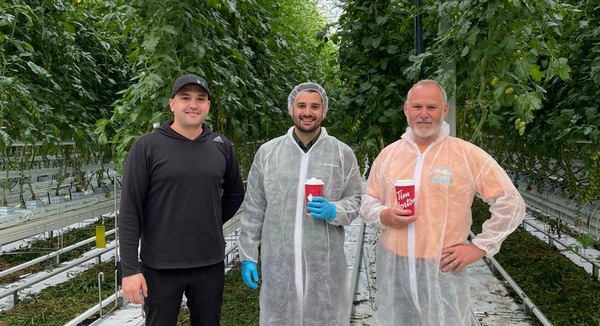Heritage Farms – a high-tech greenhouse facility in Leamington, Ontario, Canada – grows grape tomatoes exclusively for the Sunset (Mastronardi Produce) trading company, for distribution almost everywhere in Canada and also to the USA. “To maximize quality and consistency, when Phases 1 and 2 of this high-tech greenhouse facility were built in 2019, we set up an automated concept right from the start, including picking bins which are called Q-drives from bogeard with a complete buffering and for 2 phases an automatic mixing system for the “Wild Wonder” pack,” explains Pablo Rode. “We’re one of the first farms in Canada to do this. The aim is to get the product all the way out of the door without anyone touching it.”
A data-driven approach to growing
Phases 3 and 4 were constructed at Heritage Farms in 2021. To support the continued focus on quality and automation, the company’s COO of Jacks Organic, Hazel, Heritage, and Cecelia farms, Hans Van Gellecum, together with the owner Chip Stockwell, was keen to take a data-driven approach to growing facilitated by the LetsGrow.com data platform and Data-Driven Growing team.
He also saw this as the ideal opportunity to introduce the Plant Empowerment principles. “That was quite a new term for us back then, so I was initially a little skeptical since I’ve learned my craft based on the ‘traditional’ way of growing. However, I had a background in IT programming before I moved from Mexico to Canada in 2016, so I was more than willing to give data-driven growing a try,” recalls Pablo.

Local climate differences
Pablo admits that he had a few reservations at first: “At the beginning, I was concerned that the Plant Empowerment principles were based on a European climate. Of course, the climate here in Leamington is very different. We have more light intensity, the temperature fluctuations are more extreme, plus it’s more humid, which is one of our biggest issues, especially in the summer; highs are regularly around 29°C, with temperatures rarely dropping below 16°C at night.” To deal with the heat and humidity, the greenhouse is 7.20m high with high-haze double AR-coated Albarino glass from Cultilene. It is also fitted with Luxus 1147 FR screens from Svensson, which help to save energy as well as maintain an optimal climate.
“As a trial, we started by equipping one greenhouse phase with all the necessary sensors, including CARA MET sensors in the slabs. The whole greenhouse – including venting, screening, and irrigation as well as the climate – is controlled by a Hoogendoorn IIVO computer, which feeds all the data directly into LetsGrow.com,” he adds.
“But we also needed to familiarize ourselves with the Plant Empowerment principles, so we’ve spent a lot of time developing our knowledge over the past year. Besides following the training sessions provided by LetsGrow.com, we’ve learned a lot by reading the Plant Empowerment book page by page. It’s like a bible for me; whenever we have a question, we can just look it up in the book.”
Observations and recommendations
During the first year of the project, Pablo and his colleagues received lots of support with implementing the Plant Empowerment principles, especially from Evripidis Papadopoulos at LetsGrow.com. “We still have contact with Evri on a regular basis, with weekly and sometimes even daily follow-ups. He monitors and analyses all our data remotely, makes important observations, and recommends different steering strategies that help us to achieve even better results.” continues Pablo.
“The sensors give you extra ‘eyes’ in the crop so that you can make data-driven decisions about climate and energy controls to balance the individual elements, and you can also monitor the speed at which the crop grows. Without LetsGrow.com, we would be growing blind! Thanks to LetsGrow’s and Evri’s guidance and leadership, we have altered our greenhouse energy balance, moisture balance, plant energy balance, plant water balance, and the assimilate balance and achieved better production.”
Sustainable use of resources
Besides improving the quality and yield of the crop, this is also a sustainable way of growing, which is another important factor at Heritage Farms. “By understanding – and meeting – the plant’s needs more precisely, you can make more efficient use of resources when managing the climate and steering irrigation. This enables you to save energy and water, for example, and thus also costs.” states Pablo.
Stronger and healthier crop
As another benefit of following the Plant Empowerment philosophy, Pablo mentions crop health: “For the past couple of years, we have been hit by the tomato brown rugose fruit virus (ToBRFV), which cut short our last two crop cycles, and before that we struggled to control blossom end rot. Pest management is a very hot topic right now, and we’re striving to reduce our use of chemicals.”
“We’re now taking a holistic view of the optimal temperatures and humidity levels through the use of screening, better air quality and more air rotation, the right nutrients in the slab, and a better assimilate balance. And the results look very promising. We finally expect to complete a full ten-month crop cycle this year, putting us on track to achieve 30kg per m2. In fact, we hope to push through to October or November, which will be nearly a whole year since planting. So it has been a real asset.”
“For us, this is just the beginning of a very important and profitable project. At the end of this crop cycle, we will have baseline data that we can use for even more detailed analysis and fine-tuning next year. We definitely believe in the Plant Empowerment philosophy now, and we are already in the process of expanding this new way of thinking across all four phases at Heritage Farms.” Pablo concludes.
For more information:
Plant Empowerment
www.plantempowerment.com
